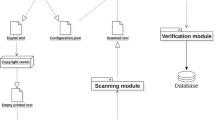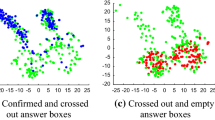Abstract
In the use of optical answer sheet examinations, occasionally the identity of the examinee is in question. A novel method for characterizing the personal quality of mark shapes in optically read answer sheets is described. The method may be used to identify imposters in multiple choice examinations. All the marks are segmented and measured in multiple parameters including area, dimensions, perimeter and optical density. Imposter decisions are made on the collected data by comparing an identified test form against the form in question in comparison with a population using SVM (support vector machine) modeling. In testing the method, 300 test forms from 100 examinees from past tests were used. An EER (equal error rate) of 15–17% was found. While performance of the presented method is currently insufficient for practical purposes, future research options have been mentioned.












Similar content being viewed by others
References
Arazi B (1977) Handwriting identification by means of run-length measurements. IEEE Trans Syst Man Cybernet 7:878–881
Bulacu M, Schomaker L (2003) Writer style from oriented edge fragments. Lecture notes in computer science, pp 460–469
Bulacu M, Schomaker L, Brink A (2007) Text-independent writer identification and verification using textural and allographic features. IEEE Trans Pattern Anal Mach Intell 29:701–717
Burges CJC (1998) A tutorial on support vector machines for pattern recognition. Data Mining Knowl Discov 2:1–47
Cortes C, Vapnik V (1995) Support-vector networks. Mach Learn 20:273–297
Franke K, Rose S (2004) Ink-deposition model: the relation of writing and ink deposition processes. In: Proceedings of the ninth international workshop on frontiers in handwriting recognition. IEEE Computer Society, Washington, DC, USA, pp 173–178
Gluhchev G, Thomas F (2005) Automatic slope evaluation of handwritten text. Int Confer Comput Syst Technol IIIA.10-1–IIIA.10-4
Hayes WL (1963) Statistics. Holt, Rinehart and Winston Inc., New York
Image Pro Plus [computer program] (2002) Version 4.5 for Windows. Media Cybernetics Inc., Bethesda
Joachims T (1999) Making large-scale SVM learning practical. In: Joachims T, Schölkopf B, Burges C, Smola A (eds) Advances in kernel methods: support vector learning. MIT Press, Cambridge
Kozinets BN et al (1967) Identification and differentiation of handwritings with the help of electronic computers (in Russian). Defense Technical Information Center
Maarse FJ, Schomaker LRB, Teulings HL (1988) Automatic identification of writers. In: Conference of the Dutch psychonomic Society on human–computer interaction: psychonomic aspects table of contents, Springer-Verlag New York, Inc. New York, pp 353–360
Martin A, Doddington G, Kamm T, Ordowski M, Przybocki M (1997) The DET curve in assessment of detection task performance. In: Proceedings of the 5th European conference on speech communication and technology: eurospeech; 1997 September 22–25; Rhodes, Greece, pp 1895–1898
Mikkilineni AK, Arslan O, Chiang PJ, Kumontoy RM, Allebach JP, Chiu GTC et al (2005) Printer forensics using SVM techniques. In: Proceedings of the IS&T’s NIP21: international conference on digital printing technologies; 2005 September 18–23, Baltimore, MD, pp 223–226
Niels R, Vuurpijl L, Schomaker L (2007) Automatic allograph matching in forensic writer identification. Int J Pattern Recognit Artif Intell 21:61–82
Özgündüz E, Şentürk T, Karshgil ME (2005) Offline Signature Verification and Recognition by Support Vector Machine. In: European signal processing conference, EUSIPCO
Pervouchine V, Leedham G (2007) Extraction and analysis of forensic document examiner features used for writer identification. Pattern Recognit 40:1004–1013
Plamondon R et al (2000) Online and off-line handwriting recognition: a comprehensive survey. IEEE Trans Pattern Anal Mach Intell 22:63–84
Schomaker L, Bulacu M, Franke K (2004) Automatic writer identification using fragmented connected-component contours. In: Frontiers in handwriting recognition, 2004. IWFHR-9 2004. Ninth international workshop on frontiers in handwriting recognition, pp 185–190
Slavík P, Govindaraju V (2000) An overview of run-length encoding of handwritten word images. Technical Report, Department of Computer Science, State University of New York at Buffalo
Vapnik VN (1995) The nature of statistical learning theory. Springer, New York
Acknowledgments
The authors express their appreciation to Prof. Naftali Schweitzer and Dr. Victor Neeman for their indispensable assistance in guiding and counseling in the answer sheet processing activities and to the National Institute for Testing and Evaluation for supplying the answer sheet samples.
Author information
Authors and Affiliations
Corresponding author
Rights and permissions
About this article
Cite this article
Levi, J.A., Solewicz, Y.A., Dvir, Y. et al. Method of verifying declared identity in optical answer sheets. Soft Comput 15, 461–468 (2011). https://doi.org/10.1007/s00500-009-0526-x
Published:
Issue Date:
DOI: https://doi.org/10.1007/s00500-009-0526-x




